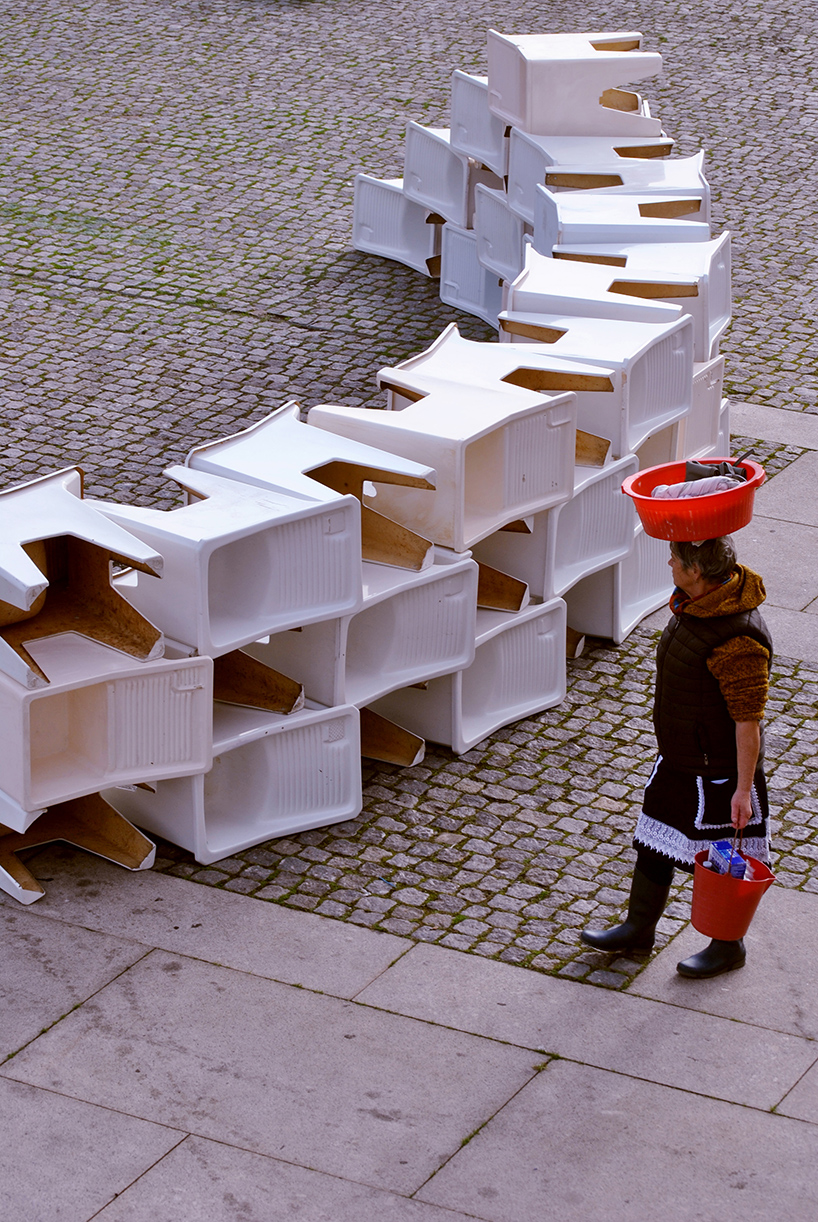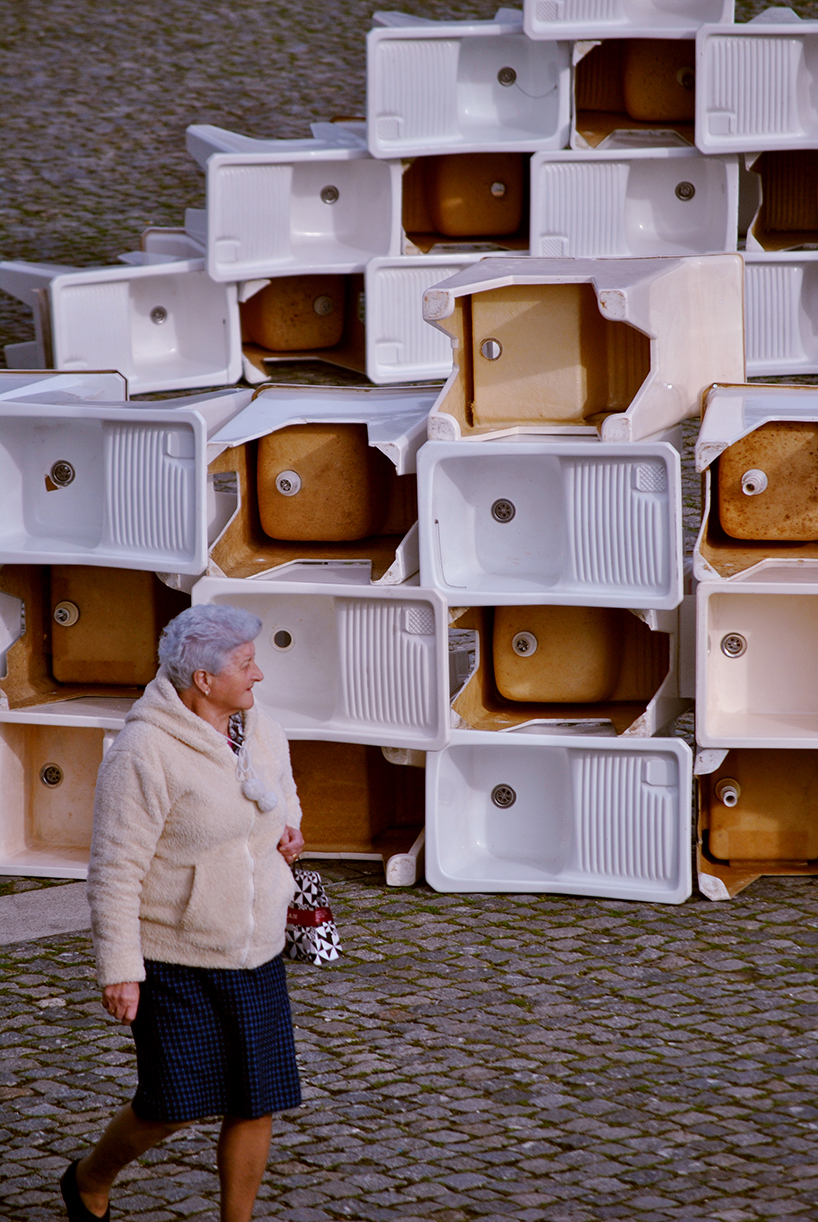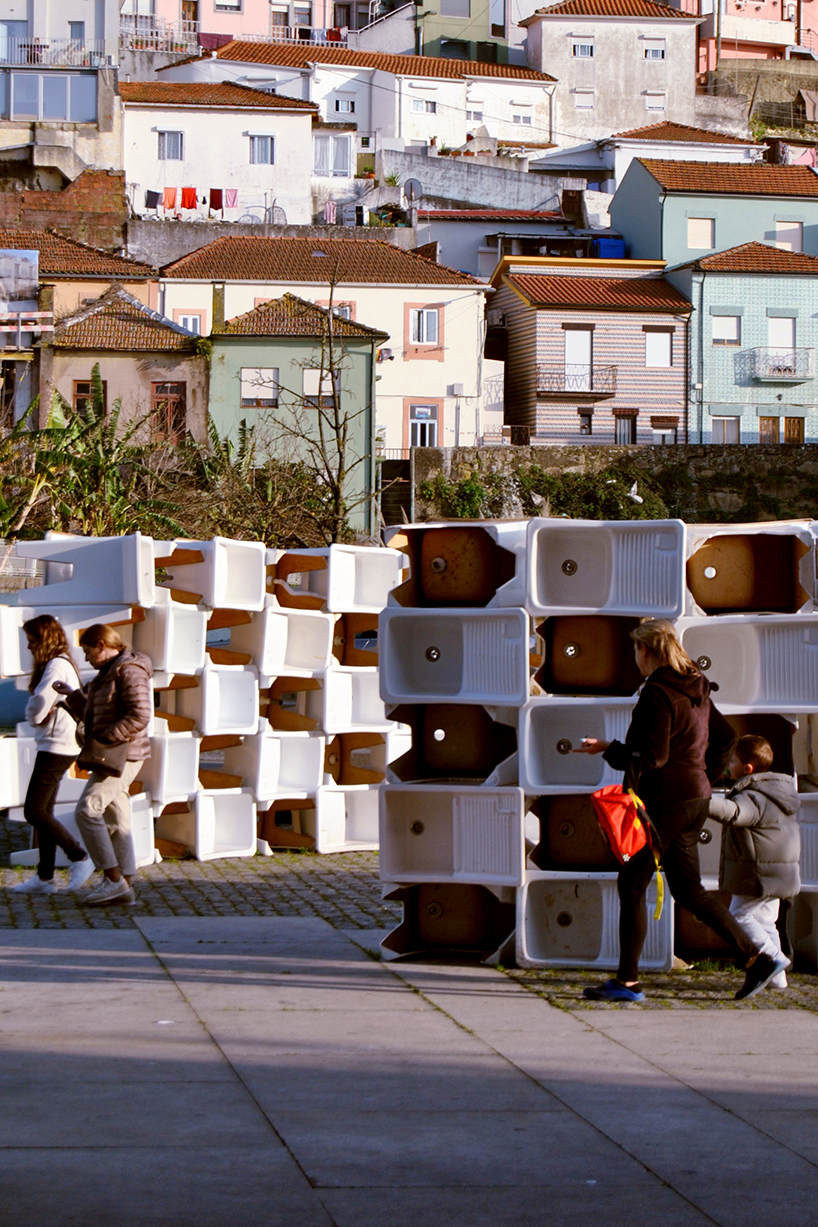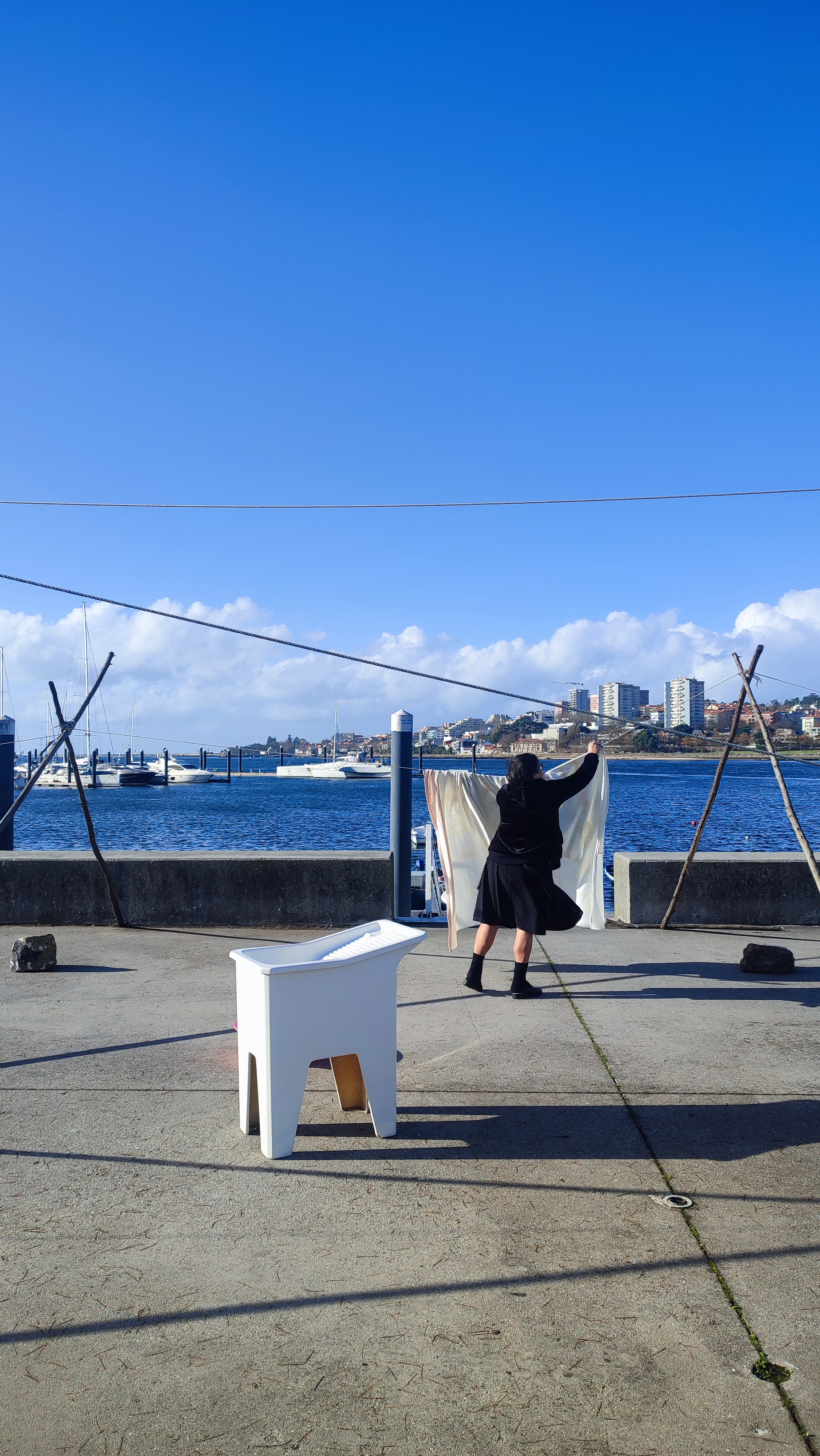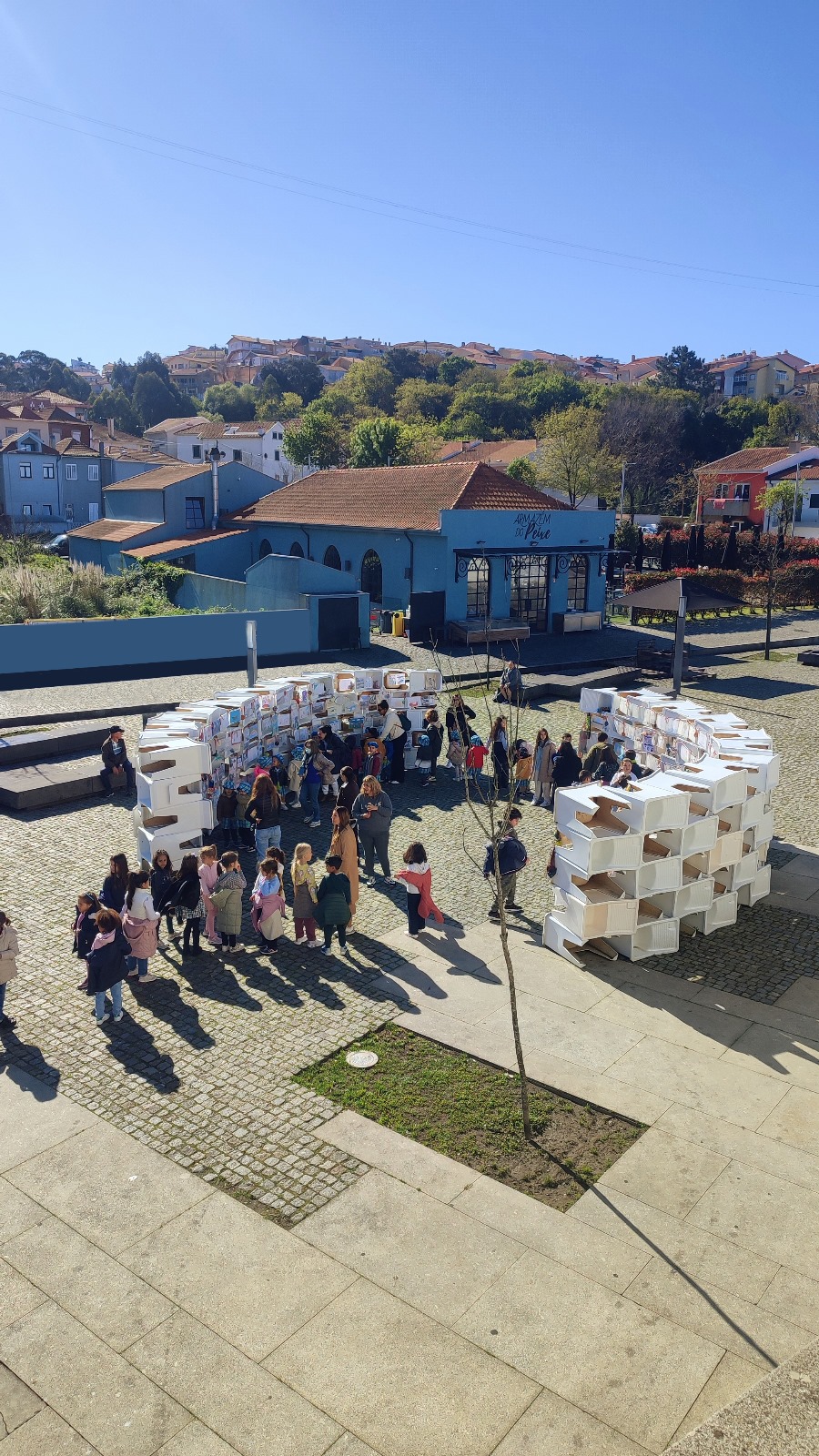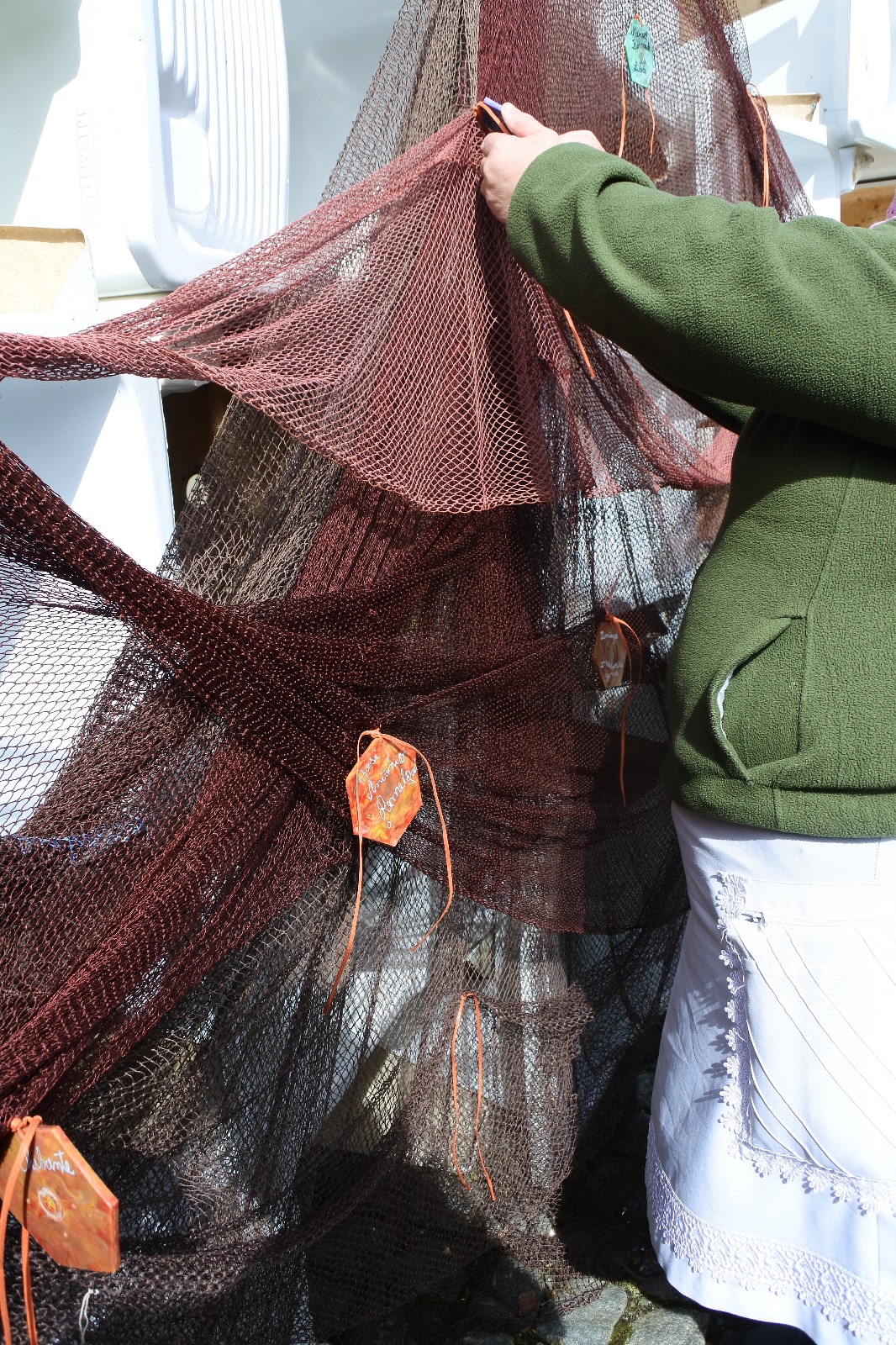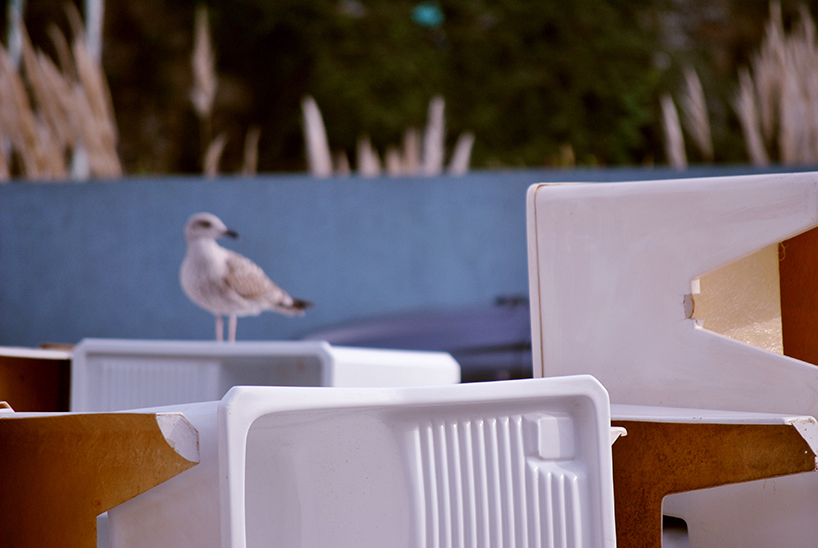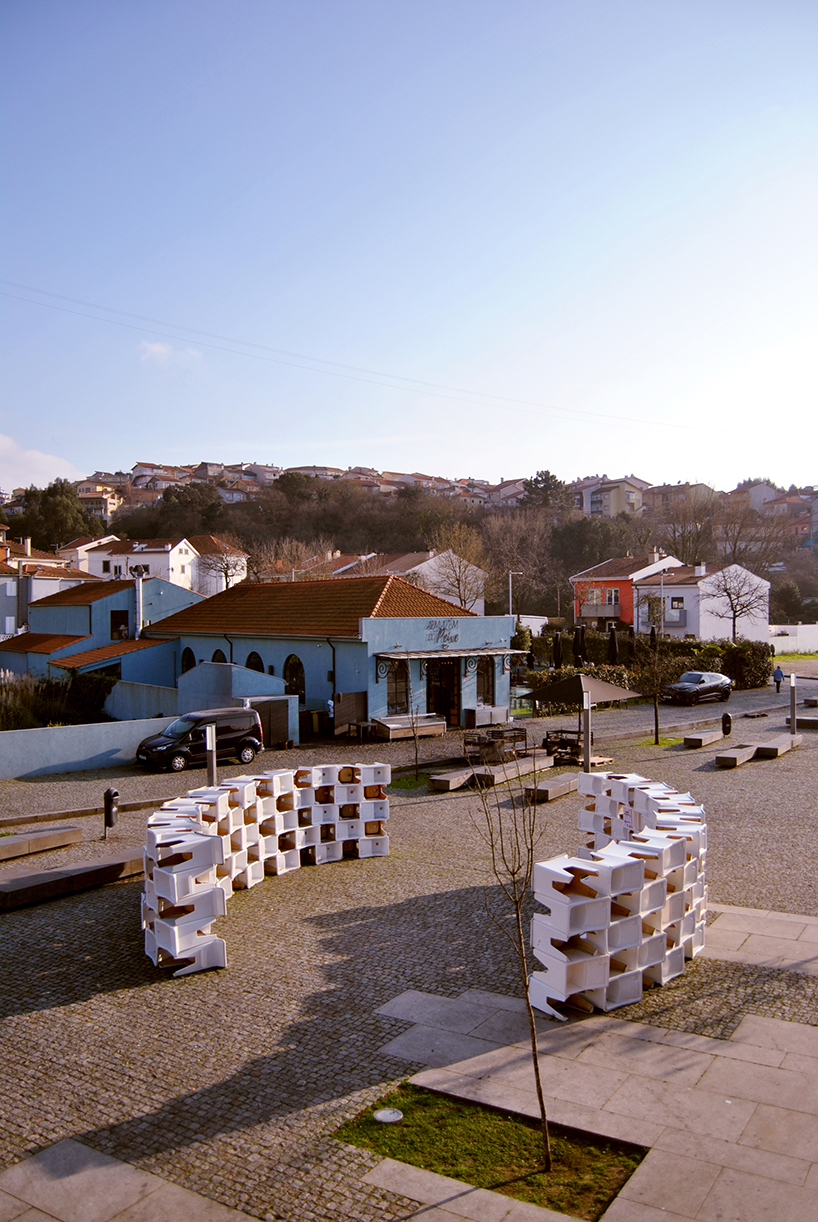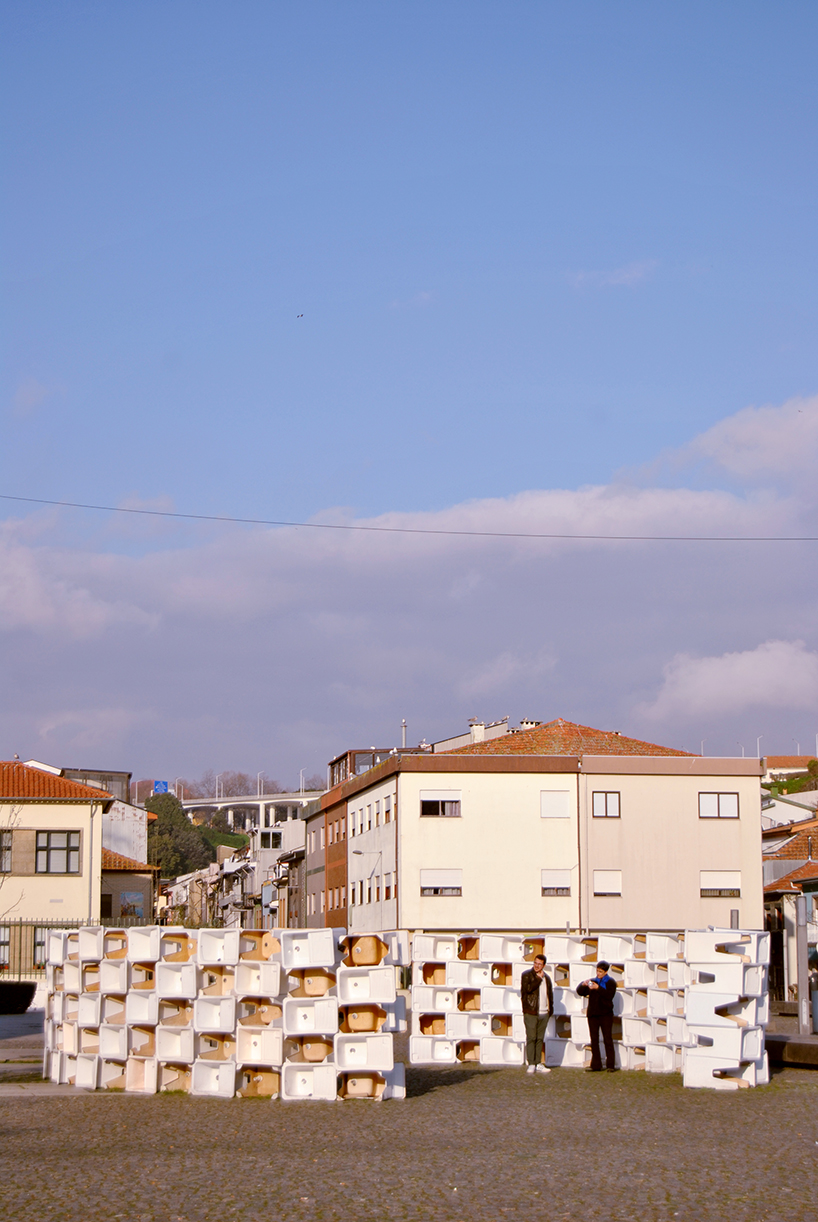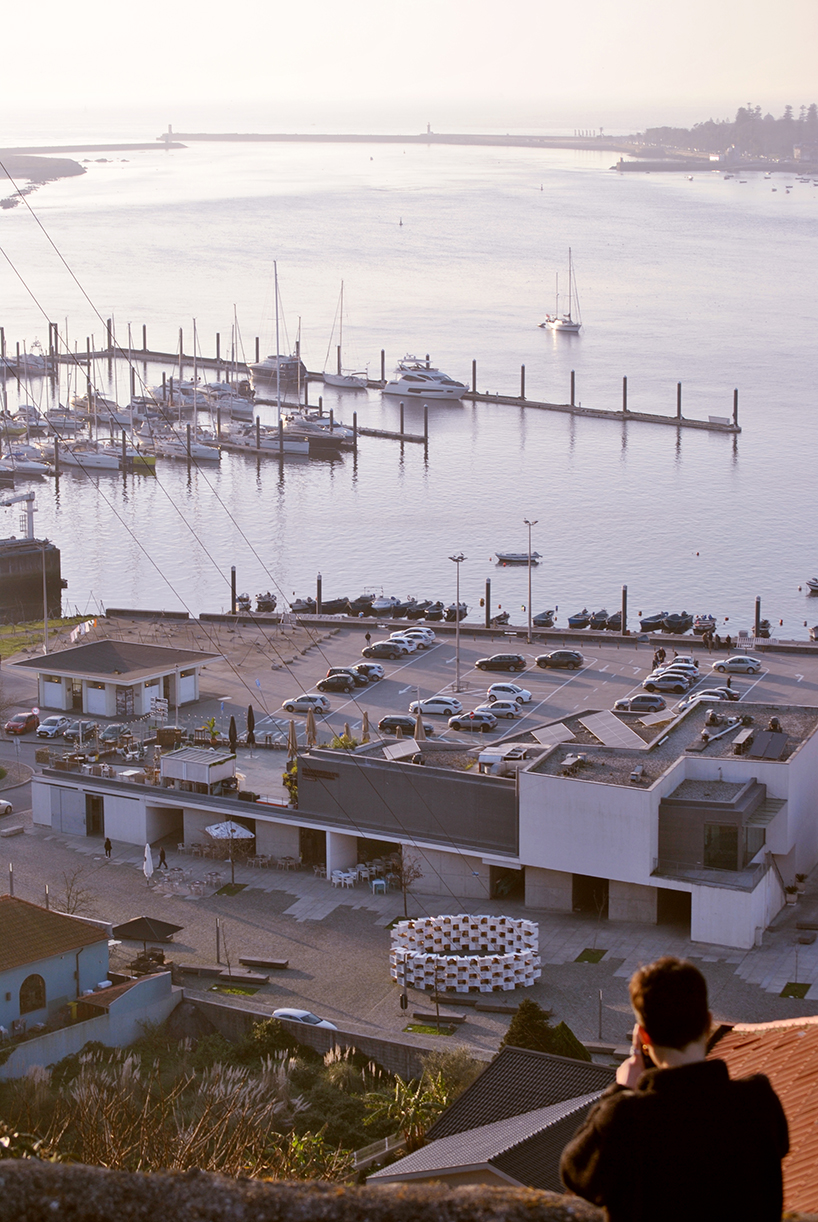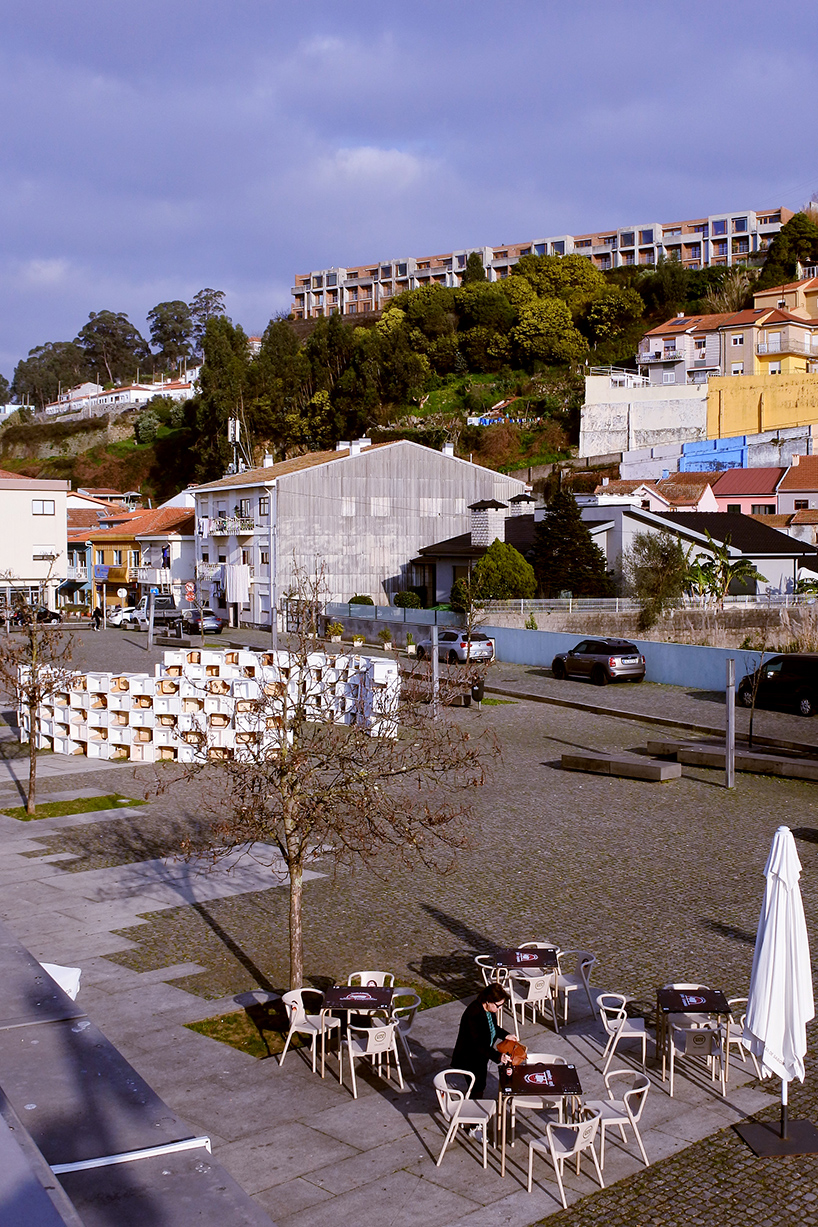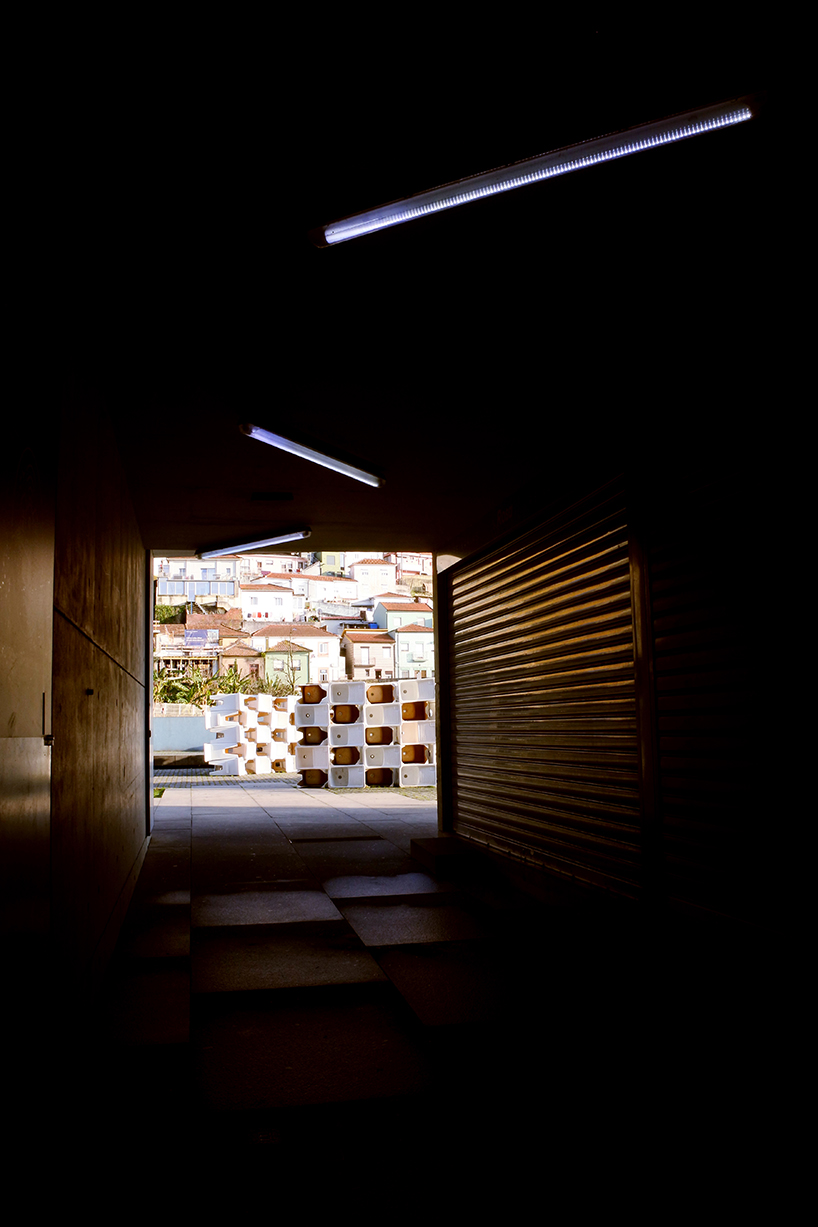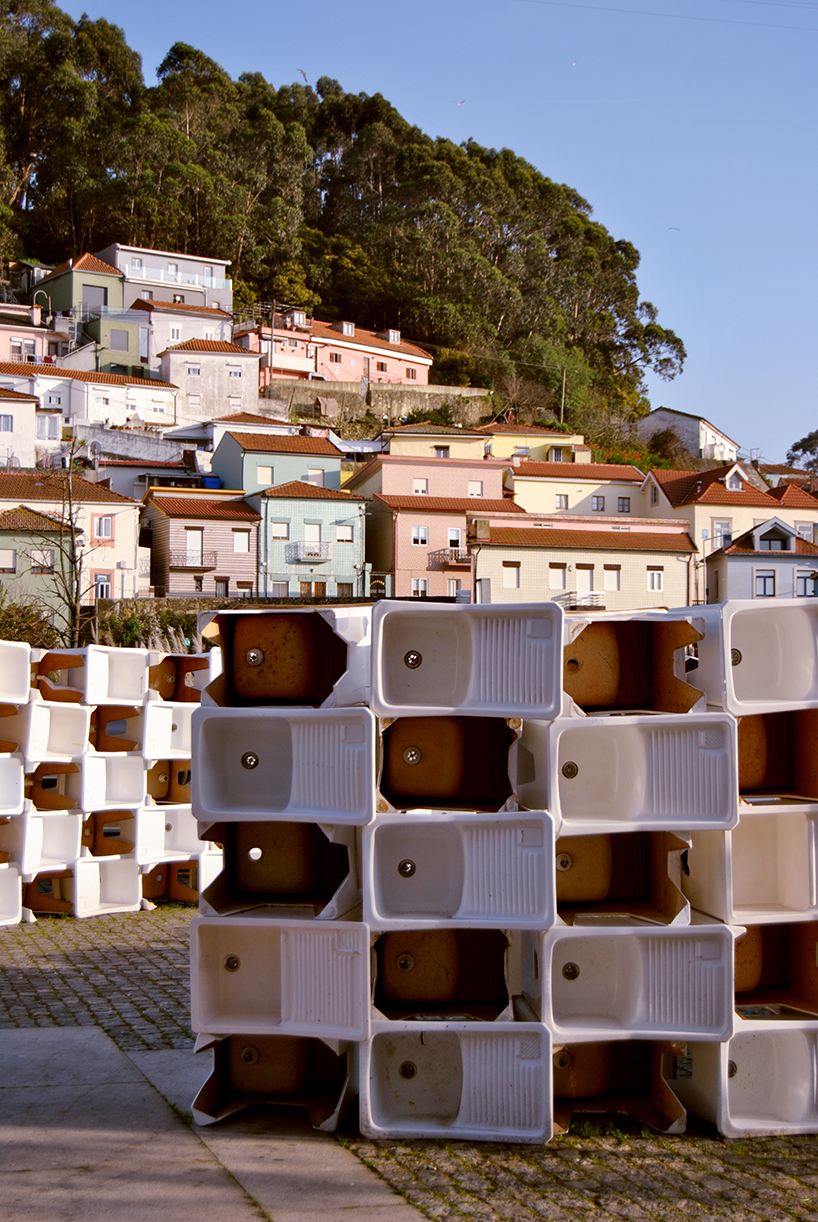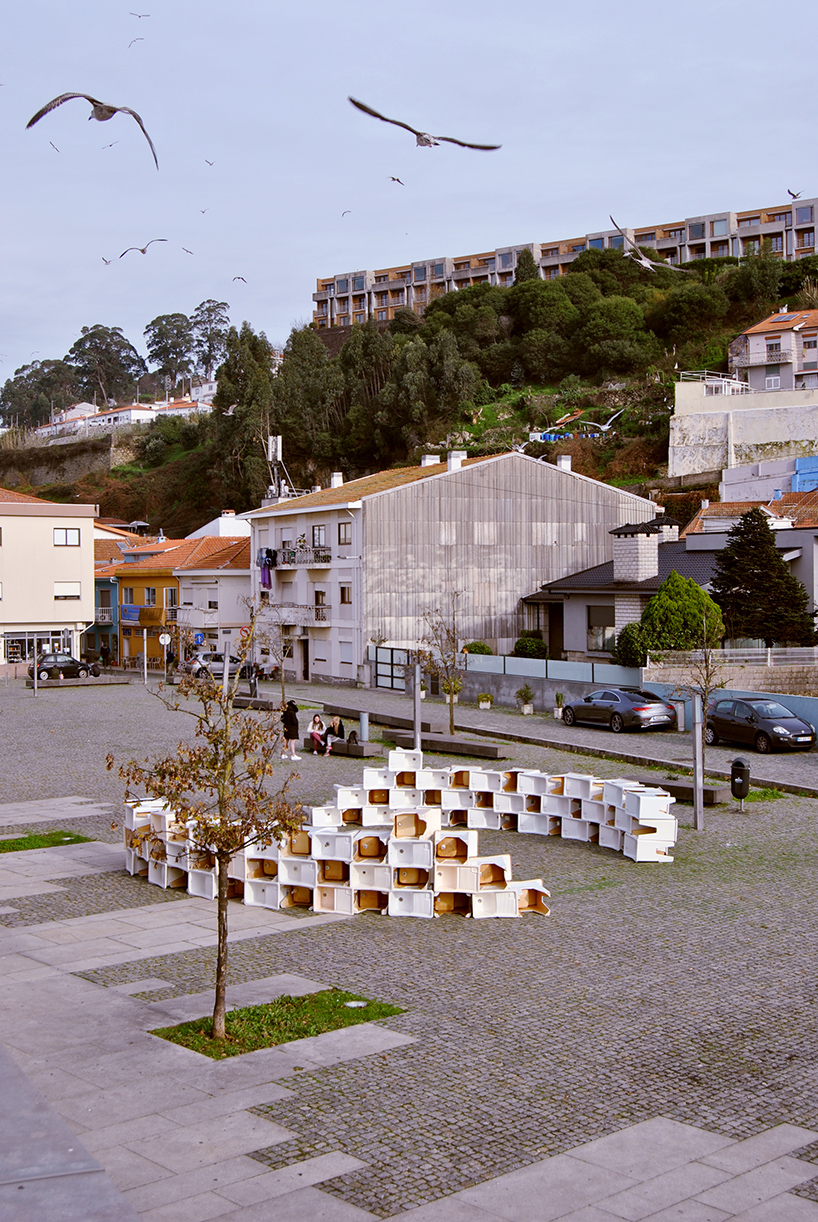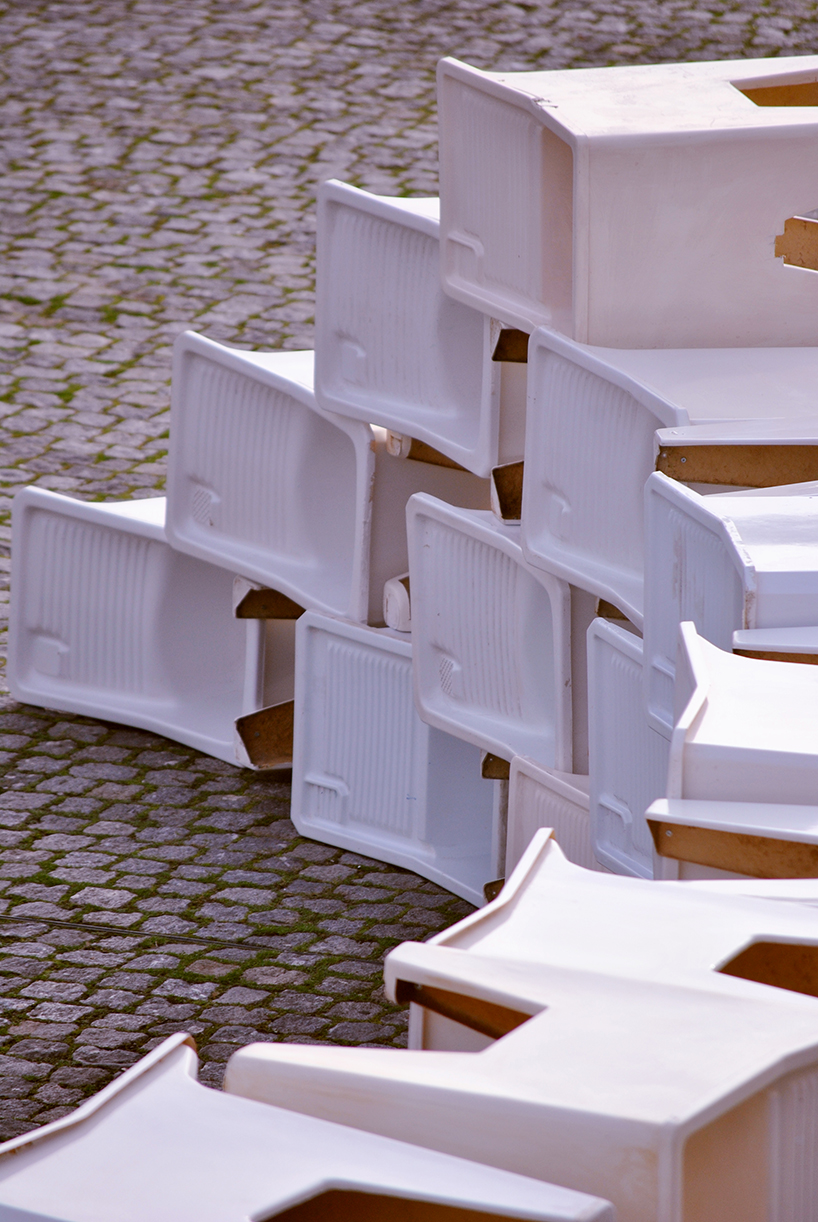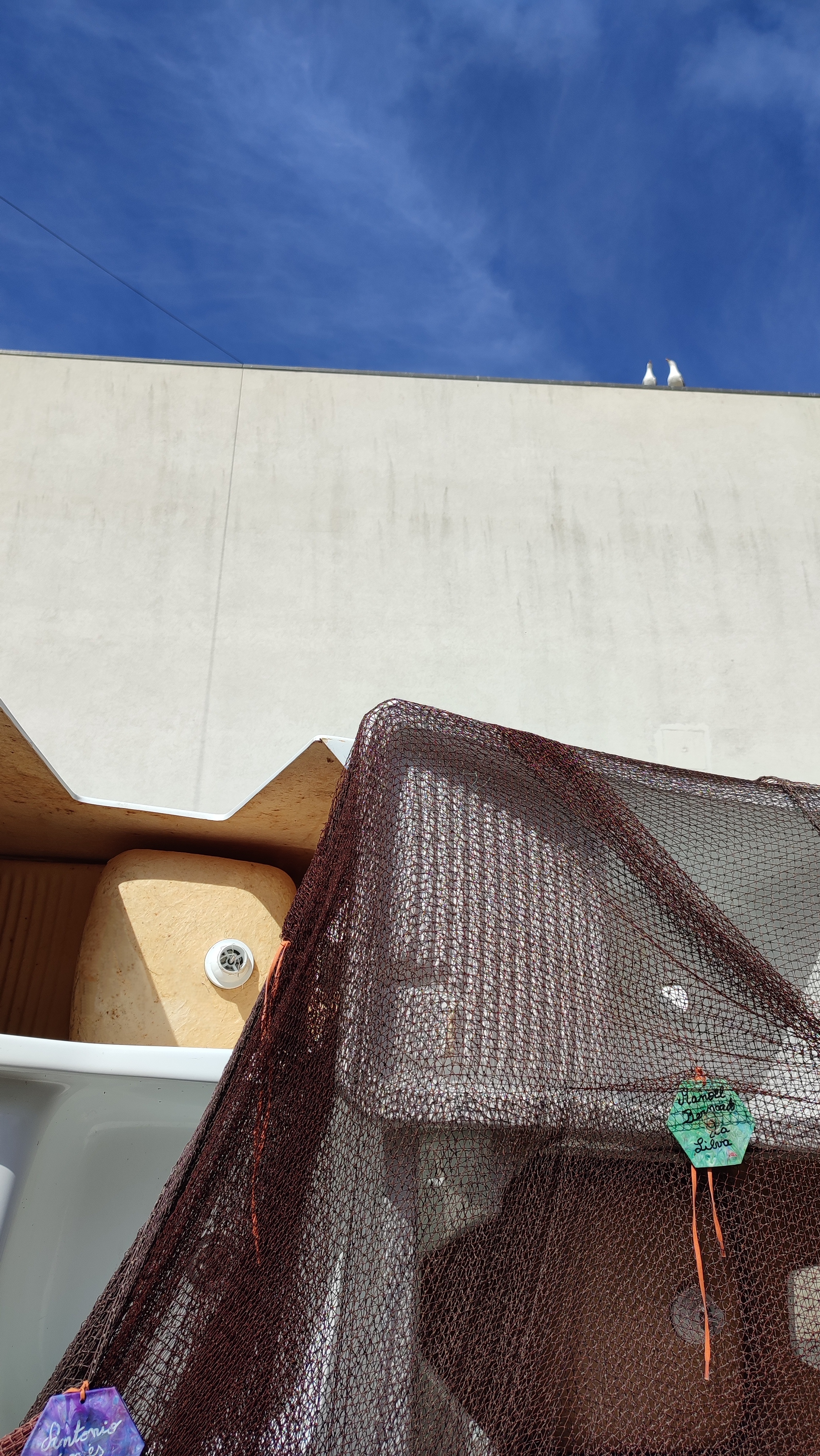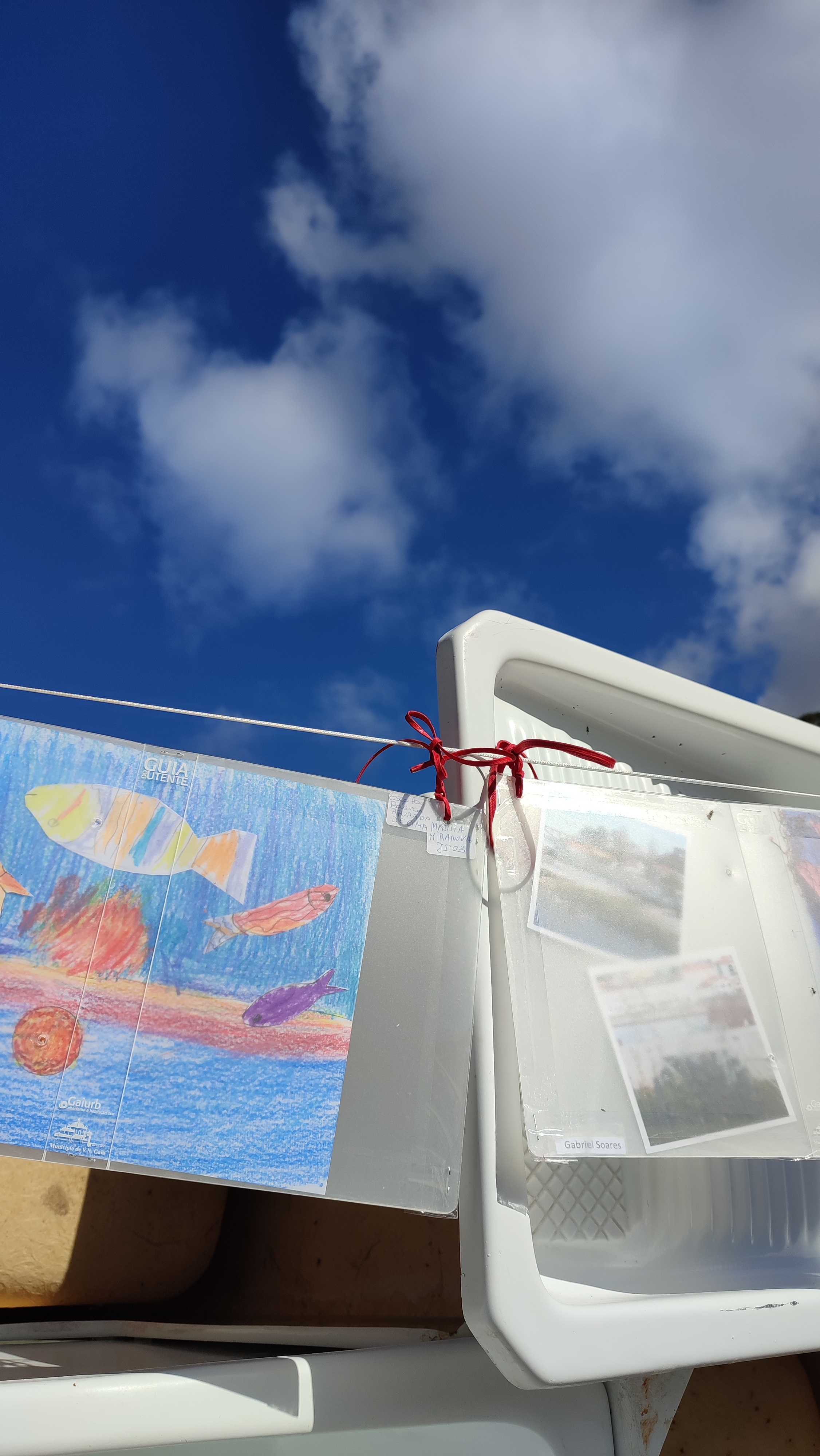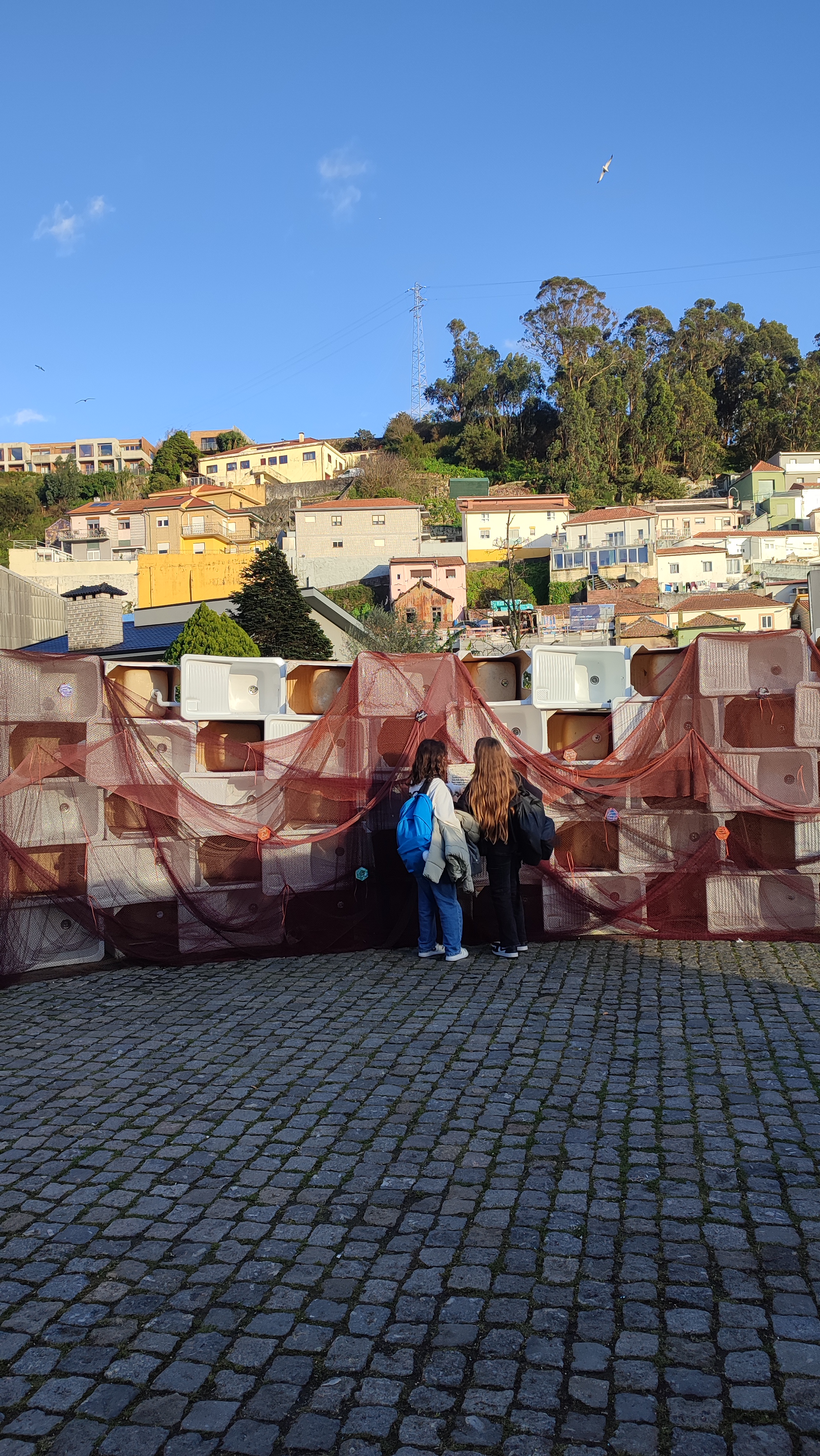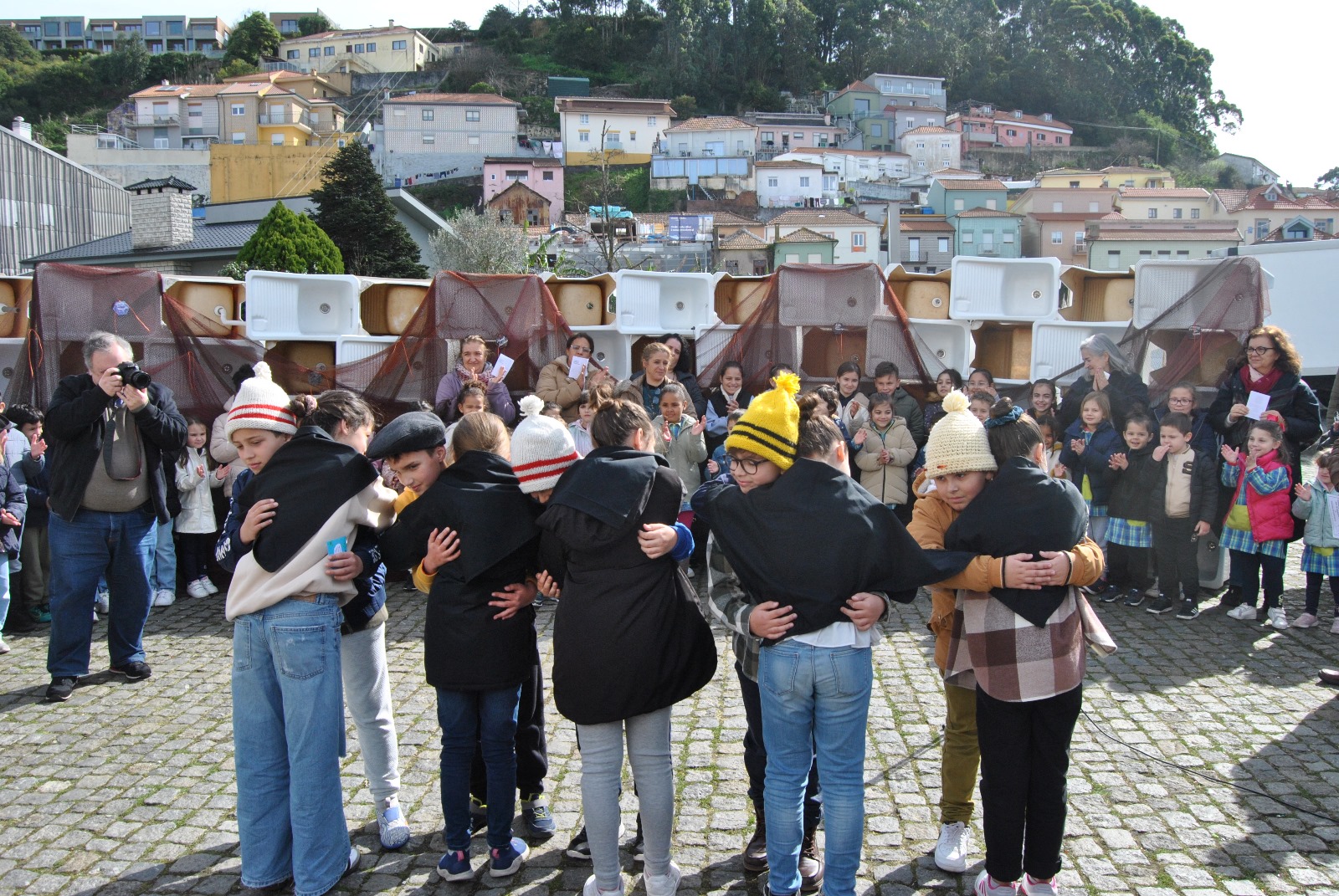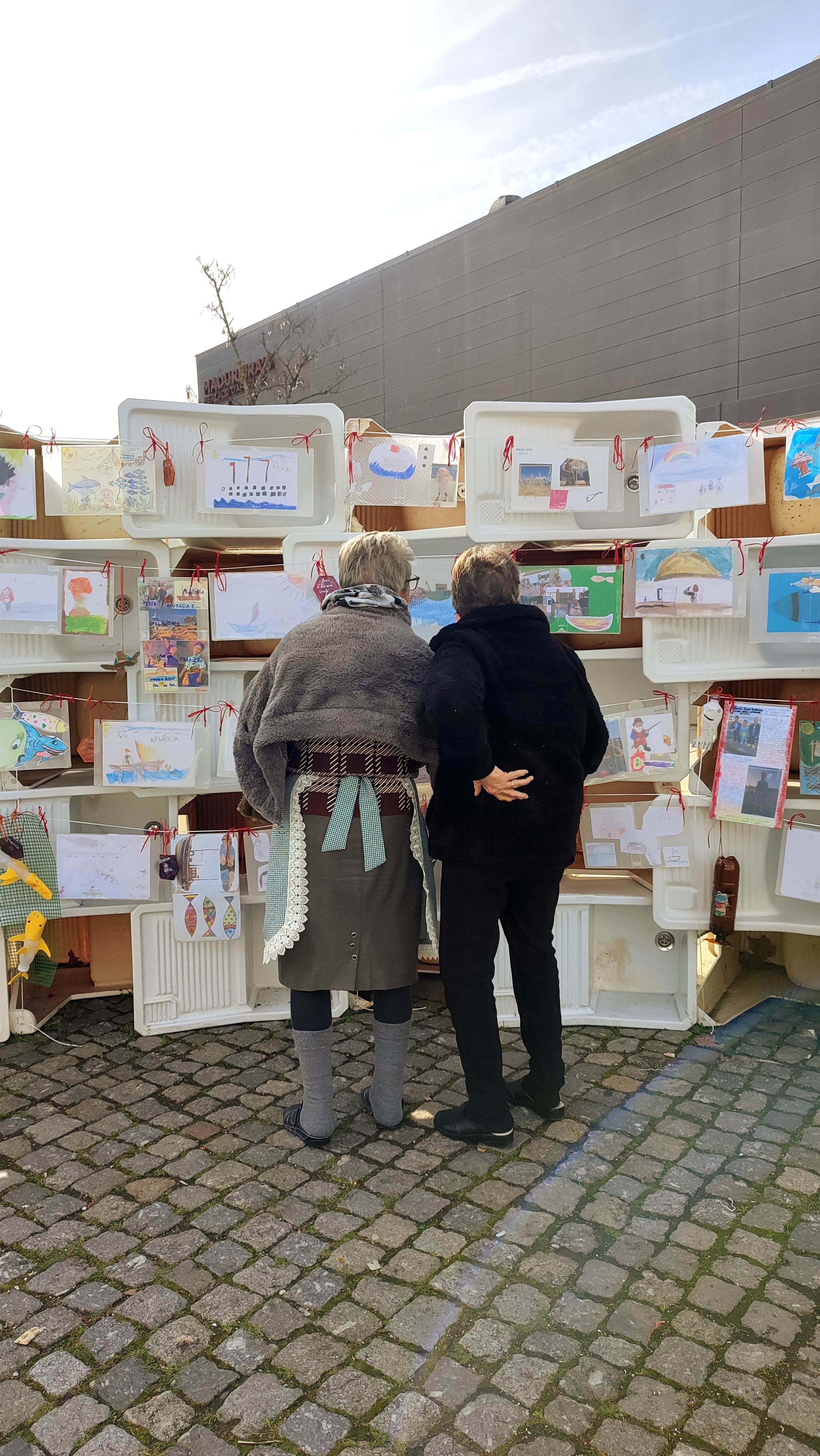Shaping a circular industrial ecosystem and supporting life-cycle thinking
Sabão
{Empty}
Using reclaimed washing tanks, Sabão transformed a fishing market plaza into a vibrant, evolving work of art inspired by the neighborhood's iconic clotheslines. Over four months, it becomes a collective canvas where community voices and contributions weave an ever-changing tapestry of stories, celebrating Afurada's identity and history through shared creativity. A tribute to the spirit of renewal, collaboration, and cultural pride in the neighborhood.
Portugal
Local
Afurada, Vila Nova de Gaia, Portugal
Mainly urban
It refers to a physical transformation of the built environment (hard investment)
Yes
2024-03-26
No
No
No
As a representative of an organisation
Sabão, meaning soap in portuguese, was an urban intervention that transformed a Fishing neighbourd market square into a living artwork through the creative reuse of 150 washing tanks, originally sourced from social housing projects. Over a four‐month period, the project engaged local residents, schools, and cultural organisations in a participatory process that reimagined everyday discarded objects as symbols of collective memory and renewal.
The overall aim was to foster community identity and environmental awareness by turning waste into art. Specific objectives were to strengthen local heritage, promote sustainable practices through circular design, and reinvigorate public space with intergenerational dialogue and creative collaboration.
Sabão integrated the New European Bauhaus values by demonstrating sustainability (through material reuse and low-impact construction), aesthetics (by transforming utilitarian objects into an evolving, culturally rich installation), and inclusion (by engaging all segments of the community). Outcomes included enhanced public space, increased local pride, a replicable model for urban regeneration, and educational impacts that encouraged citizens to see waste as a resource for creative expression.
The overall aim was to foster community identity and environmental awareness by turning waste into art. Specific objectives were to strengthen local heritage, promote sustainable practices through circular design, and reinvigorate public space with intergenerational dialogue and creative collaboration.
Sabão integrated the New European Bauhaus values by demonstrating sustainability (through material reuse and low-impact construction), aesthetics (by transforming utilitarian objects into an evolving, culturally rich installation), and inclusion (by engaging all segments of the community). Outcomes included enhanced public space, increased local pride, a replicable model for urban regeneration, and educational impacts that encouraged citizens to see waste as a resource for creative expression.
Circularity
Sustainability
Community
Heritage
Renewal
Sabão exemplified sustainable urban intervention by repurposing 150 washing tanks that would otherwise have become waste. The project embraced circular economy principles by transforming these discarded objects into the building blocks of a public artwork, reducing environmental impact and promoting material reuse. Lightweight, reversible assembly methods ensured minimal alteration to the urban fabric, while locally sourced materials, such as reclaimed fishing nets, reinforced environmental responsibility.
Moreover, Sabão served as an educational platform. Workshops and community events informed residents about waste reduction and sustainable practices, demonstrating that art could drive urban regeneration while addressing ecological challenges. The project’s success in integrating sustainability into every phase of design and execution provided a replicable model for low-cost, high-impact urban renewal, setting an exemplary standard within the New European Bauhaus framework.
Moreover, Sabão served as an educational platform. Workshops and community events informed residents about waste reduction and sustainable practices, demonstrating that art could drive urban regeneration while addressing ecological challenges. The project’s success in integrating sustainability into every phase of design and execution provided a replicable model for low-cost, high-impact urban renewal, setting an exemplary standard within the New European Bauhaus framework.
The project took an everyday object in traditional Portuguese houses, the washing tank, and elevates it into a sculptural and symbolic form. Once associated with domestic labor and shared social rituals, these tanks are reassembled into a striking urban landscape that invites contemplation, interaction, and participation. The result is an installation that is both unexpected and deeply familiar, challenging perceptions of what constitutes art in public space.The installation was conceived as a collective canvas, where local residents and schoolchildren were invited to contribute artistic elements. Through workshops, participants and students created collages, drawings, poetry, and personal testimonies that were later incorporated into the artwork, turning the structure into a patchwork of community voices. Additionally, discarded fishing nets and repurposed textiles were integrated into the installation, adding layers of color and texture that visually connected the piece to Afurada’s rich maritime identity.
In this way, the demonstrated an unique approach to aesthetics, where beauty is not imposed but emerges through collaboration, storytelling, and collective imagination. It helped us to redifined the role of public art, showing that aesthetic quality can be deeply intertwined with participation and community engagement.
In this way, the demonstrated an unique approach to aesthetics, where beauty is not imposed but emerges through collaboration, storytelling, and collective imagination. It helped us to redifined the role of public art, showing that aesthetic quality can be deeply intertwined with participation and community engagement.
Sabão was conceived as an inclusive initiative that engaged a diverse cross-section of the community. The project was implemented in a central, accessible public space, ensuring that people from all backgrounds could participate. Local schools, community groups, and families were involved from planning through to execution, creating a platform where every voice could be heard.
The washing tanks themselves, symbols of past communal domestic life, were reinterpreted as emblems of shared heritage. This recontextualisation invited both older residents and younger generations to contribute, fostering intergenerational dialogue and mutual respect. Workshops and participatory sessions enabled citizens to share personal stories, creative ideas, and artistic contributions, thereby embedding local traditions into the fabric of the artwork. Sabão’s open, collaborative process demonstrated that public art could promote social cohesion and empower communities, setting a new benchmark for inclusive urban interventions aligned with the New European Bauhaus principles.
The washing tanks themselves, symbols of past communal domestic life, were reinterpreted as emblems of shared heritage. This recontextualisation invited both older residents and younger generations to contribute, fostering intergenerational dialogue and mutual respect. Workshops and participatory sessions enabled citizens to share personal stories, creative ideas, and artistic contributions, thereby embedding local traditions into the fabric of the artwork. Sabão’s open, collaborative process demonstrated that public art could promote social cohesion and empower communities, setting a new benchmark for inclusive urban interventions aligned with the New European Bauhaus principles.
From the beginning, Sabão was shaped by the people of Afurada. Local residents weren’t just spectators as they were part of every step, from the first ideas to the final dismantling. Workshops with schools and cultural groups became spaces for exchange, where people shared their stories, created collages and drawings, and brought their own touch to the evolving installation.
This bottom-up, community-driven approach made Sabão much more than just an artwork. It became a reflection of the neighborhood, infused with the energy and pride of those who took part. What started as a pile of forgotten washing tanks turned into something meaningful, a space that belonged to everyone. And even after it was gone, the connections and conversations it sparked continued, leaving a lasting imprint on the community.
This bottom-up, community-driven approach made Sabão much more than just an artwork. It became a reflection of the neighborhood, infused with the energy and pride of those who took part. What started as a pile of forgotten washing tanks turned into something meaningful, a space that belonged to everyone. And even after it was gone, the connections and conversations it sparked continued, leaving a lasting imprint on the community.
Sabão’s success is rooted in its multi-level stakeholder engagement. At the local level, community members, schools, and the parish council provided crucial support and input. Regional partners such as the Afurada Living Lab and Gaiurb contributed technical expertise and logistical assistance, while cultural organisations helped to amplify the project’s message. This way of working wasn’t just about bringing together different skills and resources, it made sure the project stayed rooted in local realities while also connecting to broader European sustainability goals. The involvement of so many voices gave it real weight, made its impact stronger, and turned it into a replicable model for future initiatives.
Sabão was designed and implemented as an architectural and artistic intervention, but its success was deeply tied to collaborations with local educators and institutional representatives. Teachers from local schools played a key role in engaging students, integrating the project into educational activities, and fostering intergenerational exchanges. Representatives from the local parishes provided institutional support, helping to connect the project with the broader community and ensuring its alignment with local needs.
These collaborations enriched the project by creating opportunities for dialogue and active participation. The involvement of schools allowed children to develop a sense of ownership over the space, while institutional support helped amplify the project’s reach and impact. This collective process strengthened the social dimension of Sabão, proving that architectural and artistic interventions can gain greater meaning and longevity through direct engagement with local stakeholders.
These collaborations enriched the project by creating opportunities for dialogue and active participation. The involvement of schools allowed children to develop a sense of ownership over the space, while institutional support helped amplify the project’s reach and impact. This collective process strengthened the social dimension of Sabão, proving that architectural and artistic interventions can gain greater meaning and longevity through direct engagement with local stakeholders.
Sabão distinguished through its innovative fusion of art, sustainability, and community participation. Sabão was a dynamic, evolving project co-created with local residents. Its innovative use of reclaimed washing tanks,everyday objects reimagined as art, helped us to challenge conventional perceptions and underscored the potential of upcycling in urban renewal.
The project integrated reused materials looking to promote circular economy principles and redefining waste management. Sabão’s participatory methodology, which involved hands-on workshops and intergenerational dialogue, created a flexible model that adapted to local cultural and environmental conditions. This approach not only enriched the artistic quality of the installation but also served as a catalyst for social cohesion and urban regeneration. In doing so, the project set a new benchmark for innovative, people-centered urban interventions that combine environmental responsibility with cultural vibrancy.
The project integrated reused materials looking to promote circular economy principles and redefining waste management. Sabão’s participatory methodology, which involved hands-on workshops and intergenerational dialogue, created a flexible model that adapted to local cultural and environmental conditions. This approach not only enriched the artistic quality of the installation but also served as a catalyst for social cohesion and urban regeneration. In doing so, the project set a new benchmark for innovative, people-centered urban interventions that combine environmental responsibility with cultural vibrancy.
Sabão followed a participatory, phased approach that blended community engagement with sustainable design. It began with in-depth research, including workshops and meetings with residents, schools, and cultural groups, ensuring the project reflected local identity.150 washing tanks from social housing were collected, restored, and assembled using reversible techniques, allowing the installation to evolve. The project unfolded in four stages: investigation, construction, celebration, and deconstruction, each shaped by community feedback.This flexible process ensured that Sabão remained responsive to environmental and social needs. More than an artwork, it became a shared experience,strengthening local ties, fostering pride, and providing a scalable model for urban renewal.
The project demonstrated potential for transferability and replicability through its adaptable methodology and universal principles. The core concept of repurposing everyday objects,such as washing tanks, into public art can be provides a blueprint for integrating art, sustainability and culture history into urban initiatives. The project’s participatory approach, which engaged local communities through workshops and collaborative design, is easily adaptable to different cultural and social settings.The phased methodology,encompassing investigation, construction, celebration, and deconstruction, provides a clear framework that can be tailored to local conditions. The use of locally sourced, reclaimed materials not only reduces environmental impact but also fosters local economic and social engagement, making the project both sustainable and community-driven. Furthermore, the partnerships established with municipal authorities, schools, and cultural organisations offer a replicable model for stakeholder collaboration. Sabão’s success in enhancing public space, fostering intergenerational dialogue, and promoting sustainable practices serves as an inspiring blueprint for similar initiatives globally.
Sabão addressed several global challenges through localized, innovative solutions. By repurposing discarded washing tanks and other reused materials, the project tackled urban waste and resource depletion, embodying circular economy principles and promoting sustainable design. This creative reuse reduced environmental impact while challenging conventional waste management practices.
Simultaneously, the installation transformed an underutilised public space into a vibrant community hub, addressing urban alienation and social fragmentation. The participatory nature of the project empowered local residents, fostering social cohesion and intergenerational dialogue. Educational workshops raised awareness of environmental sustainability and cultural heritage, equipping citizens with the knowledge to address broader ecological and social challenges.
In doing so, Sabão provided tangible examples of how art and design can offer local solutions to global issues such as climate change, waste reduction, and community disengagement. The project demonstrated that even small-scale, community-led initiatives can have a significant impact, inspiring broader urban renewal efforts and contributing to the global discourse on sustainable, inclusive living.
Simultaneously, the installation transformed an underutilised public space into a vibrant community hub, addressing urban alienation and social fragmentation. The participatory nature of the project empowered local residents, fostering social cohesion and intergenerational dialogue. Educational workshops raised awareness of environmental sustainability and cultural heritage, equipping citizens with the knowledge to address broader ecological and social challenges.
In doing so, Sabão provided tangible examples of how art and design can offer local solutions to global issues such as climate change, waste reduction, and community disengagement. The project demonstrated that even small-scale, community-led initiatives can have a significant impact, inspiring broader urban renewal efforts and contributing to the global discourse on sustainable, inclusive living.
Sabão left a lasting mark on both the physical and social fabric of this fishing neighborhood. Over four months, the installation turned the market square into a lively gathering place, drawing in schoolchildren, families, and community groups through hands-on workshops and creative activities. It became a shared space for exchange, fostering a deep sense of pride and connection among residents.
At its core, the project was about giving new life to discarded materials. More than 150 old washing tanks and other reclaimed elements were repurposed, not only reducing waste but also demonstrating the potential of circular design. Even after the installation came down, these materials found new homes, extending Sabão’s impact beyond its original form.
Beyond its environmental and social dimensions, Sabão also sparked intergenerational dialogue. Children, parents, and elderly residents all contributed in their own ways, bridging gaps and reinforcing community ties. The project caught the attention of local authorities and cultural institutions, who saw in it a model for urban regeneration that could be adapted elsewhere.
In the end, Sabão showed how art, sustainability, and inclusive design can come together to create meaningful, lasting change, one that lingers in the people who experienced it, long after the physical traces have disappeared.
At its core, the project was about giving new life to discarded materials. More than 150 old washing tanks and other reclaimed elements were repurposed, not only reducing waste but also demonstrating the potential of circular design. Even after the installation came down, these materials found new homes, extending Sabão’s impact beyond its original form.
Beyond its environmental and social dimensions, Sabão also sparked intergenerational dialogue. Children, parents, and elderly residents all contributed in their own ways, bridging gaps and reinforcing community ties. The project caught the attention of local authorities and cultural institutions, who saw in it a model for urban regeneration that could be adapted elsewhere.
In the end, Sabão showed how art, sustainability, and inclusive design can come together to create meaningful, lasting change, one that lingers in the people who experienced it, long after the physical traces have disappeared.

